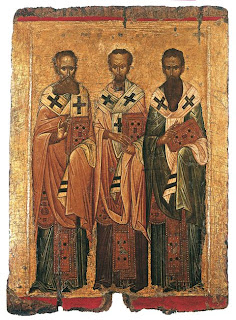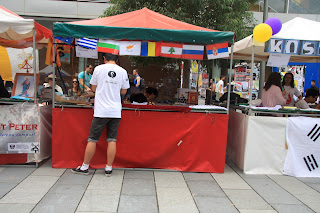The other
day, we spoke at UNSW about our experiences of Lent. So maybe I can start by
asking you what your understanding of fasting is. In medical terms, it means to
not eat. But it’s a much more common term in
religion than it is in medicine; it's an experience that most religions have.
Why? Why would anyone submit themselves to voluntary suffering?
Group
answers:
- We can
appreciate food more by not having it.
Very
true. When you're fasting from rich foods you begin to really appreciate other
things. When I'm fasting, the stuff I eat I would never touch when I'm not
fasting. So I think it is so that we can appreciate things – food or otherwise. Sometimes absence makes the heart grow
fonder. The excitement the body has by breaking the fast at Easter is very real.
| Jesus fasted after his baptism for forty days |
The Church
as a body chose to fast, it wasn’t a rule set down by God. They
took it from pre-Christian practices. The first type of fasting to be
implemented by the Church was fasting before Holy Communion. The early
Christians would have Holy Communion every day and would have a Holy Communion
meal together every day also; called the Table of Love or the Agape Feast. But
as the Church became more established and more people began to convert and
participate, the Church fathers felt that Holy Communion wasn’t being taken seriously enough as a result of the meal. So
they made a rule of 8 hours of fasting before Communion. Then you would have to
say prayers, then have Communion, and then last of all, the celebration. So,
fasting from midnight until Holy Communion, the Liturgy, and then people would come
and eat together as a family.
The
second type of fasting was Lent. The Church fathers decided on a forty day
preparation for Easter, similar to Moses spending forty days in the desert. They
made up the rules of Lent by thinking about what would be appropriate. No meat,
no dairy, and the strictest type of fast is the removal of oil too. They relieved
fasting on a weekly basis, lightened it up a bit, so on weekends you could have
wine and oil. If there's a major feast day like one which just passed, the Annunciation,
we celebrate it by eating fish. So the first level of fasting is no meat, next is
no dairy, next is no oil, then total fast, i.e. eating nothing. Next the Church
developed the idea of fasting on Wednesdays and Fridays. So in all, we are fasting
for approximately 55% of the year.
It’s a recipe for very healthy living, if you stick to the
proper fasts. A very balanced way of living; it also forces upon you a greater variety
of foods and less fussiness about the way you eat.
Back to the
“why” now. Why would the Church design fasting?
-
Self-discipline.
If you don't have discipline in your life then you become complacent.
Lots of
things are about self discipline. The first time you do a run at 5am for
example, it's torture. But the more you do it the more your body misses the run
when you don't do it. The act of prayer is equally rewarding. All types of
self-discipline are rewarding. But if we take it too far then it becomes
destructive. That which was good for us becomes bad for us. The meat that's
good for you when you need protein and iron, becomes bad for you when you eat it
all the time.
-
Makes
us more aware if all the things we need to work on in terms of our spiritual
life. Helps you become closer to your goal.
| Prophet Elijah in the desert |
A lot of
saints wrote that fasting is one of the things which make you more spiritual.
When I eat, I drown out my spirit. When I fast, my spirit gets its wing. I have
joy then, my depression goes away. I have peace and clearness of mind. They say
that your self-awareness is heightened and prayer seems to come more naturally.
So, we’ve pinpointed three things so far about fasting: appreciating
the simple things in life, exercising our body and soul, and as a result becoming
spiritually enlightened.
One of
the goals I had in this talk was to tell you that fasting us not an end in
itself. Just like the goal is the Olympic Games, not the exercise that got you
there. The goal was my degree, my time at uni got me there. The time I spent at
uni wasn’t the goal. Just like fasting
is a vehicle to get you to your goal.
There is
no point in feeling guilty when you don't fast. Just start fasting again. It's not
the goal. It's a vehicle that enriches your life and helps you to connect to
God. The connecting to God - if you think fasting will get you there you're
mistaken. Fasting is like taking the first step. If will help you pray if
you're not a prayerful person. It will help you be in church, calm your body so
that you can participate in prayer and the Liturgy.
Fasting
without prayer is of no value. So during Lent, there are more church services. It’s a beautiful extra blessing. Tonight is Wednesday, and in
most churches across Sydney they are celebrating the Liturgy of the
Presanctified Gifts.
One other
thing fasting is connected to, which the Church in Australia has almost
forgotten, is charity. If you read the lives of the Church fathers you'll see that
three things defined their lives: fasting, charity and prayer.
In a
nutshell, that's Lent. Lent is a time of restraint, of going back to the
basics. A time of spiritual exercise, a time of heightened spirituality and a
time of charity. Charity is an act of love, and therefore, as God is love, probably
the biggest way we connect to Him. Someone who prays, fasts, studies the Church,
love will start pouring out of them automatically. And that’s Christ speaking, spilling out of you, because you are becoming
a Christian, becoming like Christ, and as a result you will enter the kingdom of
Heaven. And people will want some of what you're having.
These
things have to be sprinkled throughout your life, but during Lent the church
says let's go hard. Let's have a good camp. Let’s
take it to the next level. And we can help each other. It's a journey, an
agreed journey by the group towards Easter. Let's journey towards it, not just
remember all this stuff on Easter Saturday. Let's start exercising, preparing
forty days in advance. And if you do it well, then Easter becomes a mystical
celebration within you.
There are
only two weeks to go until Easter. Lent is almost finished. But there is still
time.
The
biggest thing the Church emphasises during Lent is repentance. Repentance is
about changing, reflecting on yourself, putting your sins aside and asking God
for forgiveness. We turn black into white, death into life. Easter can become your
own personal resurrection. You kill your old self off and God brings a new
person from the ashes. And the best way to do it, to repent, to change, to
struggle, is as a group.
The
Russian Orthodox Church has a saying: there's only one thing you can do really
well by yourself, and that's go to hell. So if you stick together as a group,
then you can achieve wonderful things.
Thank you
for having me.






